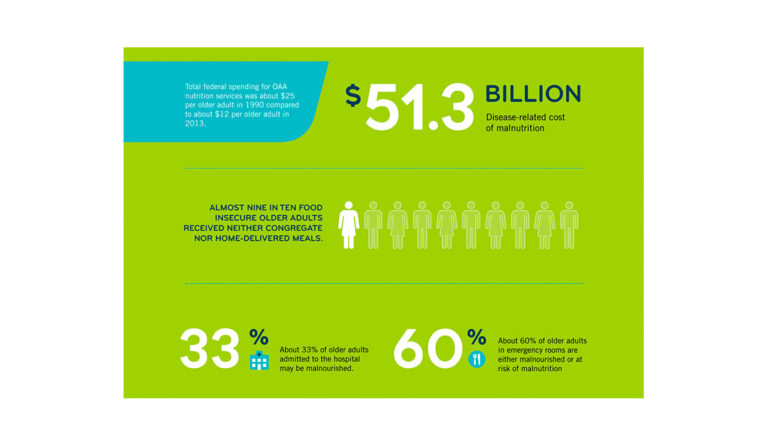Elder Malnutrition
About half of all older adults in the United States are at risk for malnutrition, leaving them highly vulnerable. Targeted public health efforts to educate the elderly, their caregivers, and policymakers could be straightforward, but funding for these programs now hangs in the balance.

Read Time: 3 minutes
Published:
The U.S. health care system is currently ill-equipped to handle the great many afflictions that lead to pervasive malnutrition in older adults. Poverty and a lack of access to nutritious foods, for instance, put about 16% of the elderly population at risk for hunger. Aging itself heightens risk: difficulty chewing, fussy dentures, decreased appetite, chronic illness, disease, and even social isolation and its resulting mental health effects are all cited as reasons that the elderly may be lacking proper nourishment.

Photo via Hunger in Older Adults. Meals on Wheels America.
About half of all older adults in the United States are at risk for malnutrition. This leaves them highly vulnerable to further disease, weakened immune systems, high hospital admissions rates, and longer hospital stays.
Consulting firm Avalere Health teamed up with the Defeat Malnutrition Today coalition in an effort to pinpoint the most effective solutions. Their resulting March 2017 “National Blueprint: Achieving Quality Malnutrition Care for Older Adults” report cites four goals. The first three—improve quality, access, and research around high-quality malnutrition care—explicitly depend on targeted public health efforts for success.
Training providers and educating the elderly, their caregivers, and policymakers could be fairly straightforward. But funding for these programs now hangs in the balance. The elderly population is growing while funding streams are stagnating, if not dwindling.
Funding for the Older Americans Act, which is administered by the Administration on Aging under the Department of Health and Human Services (HHS), has been reauthorized for the next 3 years. But as the graphic above shows, that spending has already been cut by more than half since 1990. In general, the current administration’s budget shows major cuts in HHS by 18%, or $15.1 billion. This includes the elimination of the Community Development Block Grant and the Community Services Block Grant, which state and local governments use to provide elder nutrition services like Meals on Wheels.
These block grants are not the only source of funding for such programs, but when they already cannot keep up with demand, funding losses are even more threatening to the health of the elderly. Ultimately, there may be political implications as the population most affected by this issue—Americans aged 45 and older—gave the GOP majority support in the 2016 elections.

Photo via Walbert Castillo, How We Voted By Age, Education, Race and Sexual Orientation. USA Today.
Databyte via Hunger in Older Adults. Meals on Wheels America.



